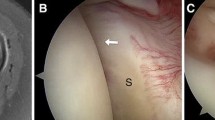Abstract
Purpose
Subscapularis tears can be difficult to diagnose and their treatment requires advanced arthroscopic skills. The objective of this study was to find the prevalence of subscapularis tears on arthroscopic examination of shoulders with rotator cuff pathology and to determine the accuracy of pre-operative ultrasound in diagnosing these tears.
Method
Ultrasound and intra-operative reports of 236 patients who underwent shoulder arthroscopy for rotator cuff pathology by the senior author at his institution were compared. Prevalence of subscapularis tear was noted and classified using Lafosse classification system. Ultrasound reports and intra-operative findings were compared to determine the accuracy, sensitivity and specificity of ultrasound in detecting subscapularis tears.
Results
The prevalence of subscapularis tears in patients needing rotator cuff repair was found to be 31.4 %. A total of 6.4 % of patients needing a rotator cuff repair had an isolated subscapularis tear. The sensitivity of ultrasound was 39.5 % and specificity 93.1 % in detection of these tears. The overall accuracy of ultrasound was 75.8 %. Sensitivity of ultrasound was low (42.8 %) for smaller (type 1 and 2) tears and higher (79 %) for larger (types 3, 4, 5) tears. The overall positive predictive value of USS was 73.1 % and negative predictive value 76.4 %.
Conclusion
The shoulder surgeon should be skilled in diagnosing and repairing subscapularis tendon tears arthroscopically and cannot completely rely on pre-operative ultrasound scans in ruling out smaller tears as its sensitivity in diagnosing smaller tears is quite low. Unsettling anterior shoulder pain with a normal ultrasound may need further arthroscopic evaluation to rule out missed subscapularis tears.





Similar content being viewed by others
References
Ziegler DW (2004) The use of in-office, orthopaedist-performed ultrasound of the shoulder to evaluate and manage rotator cuff disorders. J Shoulder Elbow Surg 13:291–297
Bryant LA, Shnier R, Bryant C (2002) Comparison of clinical estimation, ultrasonography, magnetic resonance imaging, and arthroscopy in determining the size of rotator cuff tears. J Shoulder Elbow Surg 11:219–224
Churchill R, Fehringer E, Dubinsky T (2004) Rotator cuff ultrasonography: diagnostic capabilities. J Am Acad Orthop Surg 12:6–11
Zehetgruber H, Lang T, Wurnig C (2002) Distinction between supraspinatus, infraspinatus, and subscapularis tendon tears with ultrasound in 332 surgically confirmed cases. Ultrasound Med Biol 28:711–717
de Jesus JO, Parker L, Frangos AJ, Nazarian LN (2009) Accuracy of MRI, MR arthrography, and ultrasound in the diagnosis of rotator cuff tears: a meta-analysis. AJR Am J Roentgenol 192:1701–1707
Singisetti K, Hinsche A (2011) Shoulder ultrasonography versus arthroscopy for the detection of rotator cuff tears: analysis of errors. J Orthop Surg 19(1):76–79
Garavaglia G, Ufenast H, Taverna E (2011) The frequency of subscapularis tear in arthroscopic rotator cuff repair: a retrospective study comparing magnetic resonance imaging and arthroscopic findings. Int J Shoulder Surg 5(4):91–94
Jacobson JA (2011) Shoulder US: anatomy, technique, and scanning pitfalls. Radiology 260:6–16
Snyder SJ (2002) Shoulder arthroscopy, 2nd edn. Lippincott Williams and Wilkins, Philadelphia
Lafosse L, Jost B, Reiland Y, Audebert S, Toussaint B (2007) Structural integrity and clinical outcomes after arthroscopic repair of isolated subscapularis tears. J Bone Joint Surg Am 89:1184–1193
Keating JF, Waterworth P, Shaw-Dunn J, Crossan J (1993) The relative strengths of the rotator cuff muscles. A cadaver study. J Bone Joint Surg (Br) 75:137–140
Lafosse L, Lanz U, Saintmard B, Campens C (2010) Arthroscopic repair of subscapularis tear: surgical technique and results. Orthop Traumatol Surg Res 96:S99–S108
Richards DP, Burkhart SS, Tehrany AM, Wirth MA (2007) The subscapularis footprint: an anatomic description of its insertion site. Arthroscopy 23:251–254
Kelly BT, Williams RJ, Cordasco FA (2005) Differential patterns of muscle activation in patients with symptomatic and asymptomatic rotator cuff tears. J Shoulder Elbow Surg 14:165–171
Burkhart SS, Esch JC, Jolson RS (1993) The rotator crescent and rotator cable: an anatomic description of the shoulder’s “suspension bridge”. Arthroscopy 9:611–616
Ticker JB, Burkhart SS (2011) Why repair the subscapularis? A logical rationale. Arthroscopy 27:1123–1128
Sang-Hoon L, Jin-Young P (2013) Prospective randomized comparative study of 191 subscapularis tear: clinical and radiologic outcome—arthroscopic repair vs debridement. J Shoulder Elbow Surg 10:e24–e26
Denard PJ, Burkhart SS (2013) Arthroscopic recognition and repair of the torn subscapularis tendon. Arthrosc Tech 2:373–379
Valenti P, Boughebri O, Moraiti C, Dib C, Maqdes A, Amouyel T, Ciais G, Kany J (2015) Transfer of the clavicular or sternocostal portion of the pectoralis major muscle for irreparable tears of the subscapularis. Technique and clinical results. Int Orthop 39(3):477–483. doi:10.1007/s00264-014-2566-9
Adams CR, Schoolfield JD, Burkhart SS (2010) Accuracy of preoperative magnetic resonance imaging in predicting a subscapularis tendon tear based on arthroscopy. Arthroscopy 26:1427–1433
Lo IK, Burkhart SS (2003) The etiology and assessment of subscapularis tendon tears: a case for subcoracoid impingement, the roller-wringer effect, and TUFF lesions of the subscapularis. Arthroscopy 19:1142–1150
Lo IK, Burkhart SS (2003) The comma sign: an arthroscopic guide to the torn subscapularis tendon. Arthroscopy 19:334–337
Burkhart SS, Tehrany AM (2002) Arthroscopic subscapularis tendon repair: technique and preliminary results. Arthroscopy 18:454–463
Atef A, El-Tantawy A, Gad H, Hefeda M (2015) Prevalence of associated injuries after anterior shoulder dislocation: a prospective study. Int Orthop. doi:10.1007/s00264-015-2862
Nazarian LN, Jacobson JA, Benson CB et al (2013) Imaging algorithms for evaluating suspected rotator cuff disease: society of radiologists in ultrasound consensus conference statement. Radiology 267:589–595
Acknowledgments
The authors did not receive any outside funding or grants in support of their research for or preparation of this work.
Author information
Authors and Affiliations
Corresponding author
Ethics declarations
Conflict of Interest
None
Rights and permissions
About this article
Cite this article
Narasimhan, R., Shamse, K., Nash, C. et al. Prevalence of subscapularis tears and accuracy of shoulder ultrasound in pre-operative diagnosis. International Orthopaedics (SICOT) 40, 975–979 (2016). https://doi.org/10.1007/s00264-015-3043-9
Received:
Accepted:
Published:
Issue Date:
DOI: https://doi.org/10.1007/s00264-015-3043-9




